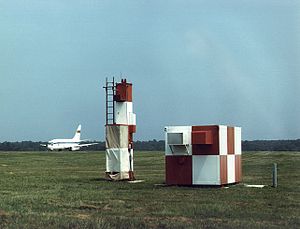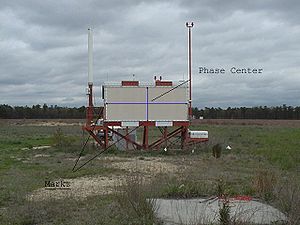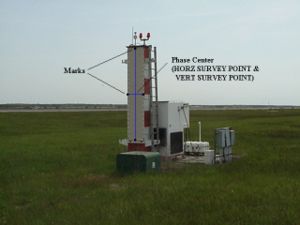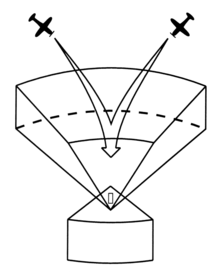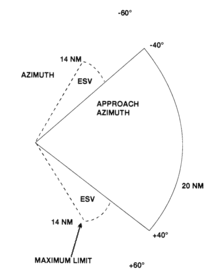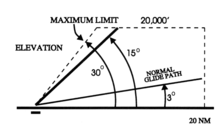- Microwave landing system
-
The NASA 737 research aircraft on the Wallops runway in 1987 with the Microwave Landing System equipment in the foreground.

A microwave landing system (MLS) is an all-weather, precision landing system originally intended to replace or supplement instrument landing systems (ILS). MLS has a number of operational advantages, including a wide selection of channels to avoid interference with other nearby airports, excellent performance in all weather, and a small "footprint" at the airports.
Although some MLS systems became operational in the 1990s, the widespread deployment initially envisioned by its designers never became a reality. GPS-based systems, notably WAAS, allowed the expectation of the same level of positioning detail with no equipment needed at the airport. GPS/WAAS dramatically lowers the cost of implementing precision landing approaches, and since its introduction most existing MLS systems in North America have been turned off. GPS/WAAS-based LPV 'Localizer Performance with Vertical guidance' approaches provide vertical guidance comparable to ILS Category I and FAA-published LPV approaches currently outnumber ILS approaches at US airports.
MLS continues to be of some interest in Europe, where concerns over the availability of GPS continue to be an issue. A widespread installation in the United Kingdom is currently underway, which included installing MLS receivers on most British Airways aircraft, but the continued deployment of the system is in doubt. NASA operated a similar system called the Microwave Scanning Beam Landing System to land the Space Shuttle.
Radio navigation aids in general (including MLS) require calibration to ensure accuracy, which is done periodically through flight inspection.
Contents
Principle
MLS employs 5GHz transmitters at the landing place which use passive electronically scanned arrays to send scanning beams towards approaching aircraft. An aircraft that enters the scanned volume uses a special receiver that calculates its position by measuring the arrival times of the beams.
History
The US version of MLS was a joint development between the FAA, NASA, and the U.S. Department of Defense, was designed to provide precision navigation guidance for exact alignment and descent of aircraft on approach to a runway. The design was e.g. advised by Herbert Raabe[1]. It provides azimuth, elevation, and distance, as well as "back azimuth", for navigating from an aborted landing or missed approach. MLS channels were also used for short-range communications with airport controllers, allowing long-distance frequencies to be handed over to other aircraft.
In Australia, design work commenced on its version of an MLS in 1972. Most of this work was jointly done by the then Federal Department of Civil Aviation (DCA), and the Radio Physics Division of the Commonwealth Scientific and Industrial Research Organisation (CSIRO). The project was called Interscan, one of several microwave landing systems under consideration internationally. Interscan was chosen by the FAA in 1975 and by ICAO in 1978 as the format to be adopted. An engineered version of the system, called MITAN, was developed by industry (Amalgamated Wireless Australasia Limited and Hawker de Havilland) under a contract with DCA's successor, the Department of Transport, and successfully demonstrated at Melbourne Airport (Tullamarine) in the late 1970s. The white antenna dishes could still be seen at Tullamarine up till 2003 before it was dismantled. This initial research was followed by the formation of Interscan International limited in Sydney, Australia in 1979 who manufactured MLS systems that were subsequently deployed in the US, EU, Taiwan, China and Australia. The CAA in UK developed a version of the MLS which is installed at Heathrow and other airports due to the greater incidence of instrument approaches and Cat II/III weather there. GPS has not yet solved the critical problems needed to match the MLS international standard.
Compared to the existing ILS system, MLS had significant advantages. The antennas were much smaller, due to using a higher frequency signal. They also did not have to be placed at a specific point at the airport, and could "offset" their signals electronically. This made placement at the airports much simpler compared to the large ILS systems, which had to be placed at the ends of the runways and along the approach path.
Another advantage was that the MLS signals covered a very wide fan-shaped area off the end of the runway, allowing controllers to vector aircraft in from a variety of directions or guide aircraft along a segmented approach. In comparison, ILS required the aircraft to fly down a single straight line, requiring controllers to distribute planes along that line. MLS allowed aircraft to approach from whatever direction they were already flying in, as opposed to flying to a parking orbit before "capturing" the ILS signal. This was particularly interesting to larger airports, as it potentially allowed the aircraft to be separated horizontally until much closer to the airport. Similarly in elevation, the fan shape coverage allows for variation in approach angle making MLS particularly suited to aircraft with steep approach angles such as helicopters, fighters and the space shuttle.
Unlike ILS, which required a variety of frequencies to broadcast the various signals, MLS used a single frequency, broadcasting the azimuth and altitude information one after the other. This reduced frequency contention, as did the fact that the frequencies used were well away from FM broadcasts, another problem with ILS. Additionally, MLS offered two hundred channels, making the possibility of contention between airports in the same area extremely remote.
Finally, the accuracy was greatly improved over ILS. For instance, standard DME equipment used with ILS offered range accuracy of only +/- 1200 feet. MLS improved this to +/- 100 ft in what they referred to as DME/P (for precision), and offered similar improvements in azimuth and altitude. This allowed MLS to guide the extremely accurate CAT III approaches, whereas this normally required an expensive ground-based high precision radar.
Similar to other precision landing systems, lateral and vertical guidance may be displayed on conventional course deviation indicators or incorporated into multipurpose cockpit displays. Range information can also be displayed by conventional DME indicators and also incorporated into multipurpose displays.
It was originally intended that ILS would remain in operation until 2010 before being replaced by MLS. The system was only being installed experimentally in the 1980s when the FAA began to favor GPS. Even in the worst cases, GPS offered at least 300 ft accuracy, not as good as MLS, but much better than ILS. Additionally, GPS worked "everywhere", not just off the end of the runways. This meant that a single navigation instrument could replace both short and long-range navigation systems, offer better accuracy than either, and required no ground-based equipment.
The major issues with GPS, namely 2 feet vertical guidance accuracy near the runway threshold and the integrity of the system has not been able to match historical ICAO standards and practices. Additional GPS accuracy could be provided by sending out "correcting signals" from ground-based stations, which would improve the accuracy to about 10 m in the worst case, far outperforming MLS. Initially it was planned to send these signals out over short-range FM transmissions on commercial radio frequencies, but this proved to be too difficult to arrange. Today a similar signal is instead sent across all of North America via commercial satellites, in a system known as WAAS. However WAAS is not capable of providing CAT II or CAT III standard signals (those required for autolanding) and so a Local Area Augmentation System, or LAAS, must be used.
Operational Functions
The system may be divided into five functions: Approach azimuth, Back azimuth, Approach elevation, Range and Data communications.
Approach azimuth guidance
The azimuth station transmits MLS angle and data on one of 200 channels within the frequency range of 5031 to 5091 MHz and is normally located about 1,000 feet (300 m) beyond the stop end of the runway, but there is considerable flexibility in selecting sites. For example, for heliport operations the azimuth transmitter can be collocated with the elevation transmitter.
The azimuth coverage extends: Laterally, at least 40 degrees on either side of the runway centerline in a standard configuration. In elevation, up to an angle of 15 degrees and to at least 20,000 feet (6 km), and in range, to at least 20 nautical miles (37 km) (See FIG 1-1-8.)
Elevation guidance
The elevation station transmits signals on the same frequency as the azimuth station. A single frequency is time-shared between angle and data functions and is normally located about 400 feet from the side of the runway between runway threshold and the touchdown zone.
Elevation coverage is provided in the same airspace as the azimuth guidance signals: In elevation, to at least +15 degrees; Laterally, to fill the Azimuth lateral coverage and in range, to at least 20 nautical miles (37 km) (See FIG 1-1-9.)
Range guidance
The MLS Precision Distance Measuring Equipment (DME/P) functions the same as the navigation DME, but there are some technical differences. The beacon transponder operates in the frequency band 962 to 1105 MHz and responds to an aircraft interrogator. The MLS DME/P accuracy is improved to be consistent with the accuracy provided by the MLS azimuth and elevation stations.
A DME/P channel is paired with the azimuth and elevation channel. A complete listing of the 200 paired channels of the DME/P with the angle functions is contained in FAA Standard 022 (MLS Interoperability and Performance Requirements).
The DME/N or DME/P is an integral part of the MLS and is installed at all MLS facilities unless a waiver is obtained. This occurs infrequently and only at outlying, low density airports where marker beacons or compass locators are already in place.
Data communications
The data transmission can include both the basic and auxiliary data words. All MLS facilities transmit basic data. Where needed, auxiliary data can be transmitted. MLS data are transmitted throughout the azimuth (and back azimuth when provided) coverage sectors. Representative data include: Station identification, Exact locations of azimuth, elevation and DME/P stations (for MLS receiver processing functions), Ground equipment performance level; and DME/P channel and status.
MLS identification is a four-letter designation starting with the letter M. It is transmitted in International Morse Code at least six times per minute by the approach azimuth (and back azimuth) ground equipment.[1]
Auxiliary data content: Representative data include: 3-D locations of MLS equipment, Waypoint coordinates, Runway conditions and Weather (e.g., RVR, ceiling, altimeter setting, wind, wake vortex, wind shear).
Future
There are different requirements when it comes to landing in Europe and the USA. In the USA, if pilots are unable to see the runway due to low visibility conditions, the aircraft can generally divert to another airport. In Europe, due to its smaller land area, low visibility can affect all airports in the vicinity, forcing planes to land in low visibility conditions.
In the United States, the FAA suspended the MLS program in 1994 in favor of the GPS (Wide Area Augmentation System WAAS). The FAA's inventory of instrument flight procedures no longer includes any MLS locations[2]; the last two were eliminated in 2008.
Many countries in Europe (particularly those known for low visibility conditions) have embraced the MLS system as a replacement to ILS.
See also
- Instrument Landing System (ILS)
- Local Area Augmentation System (LAAS)
- Transponder Landing System (TLS)
- Wide Area Augmentation System (WAAS)
- Microwave Scanning Beam Landing System
References
- ^ Dr. Herbert Raabe Dies at 95, Obituary, Potomac Almanac, 09/15/2004
- Aeronautical Information Manual
- Aviation Today MLS: Back to the Future? April 1, 2003 article about new installation of MLS at London Heathrow Airport
External links
Categories:- Aircraft landing systems
- Radio navigation
- Types of approaches
Wikimedia Foundation. 2010.

